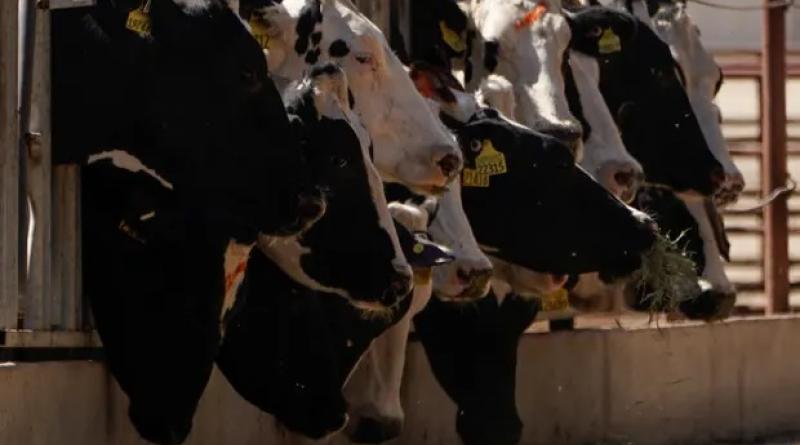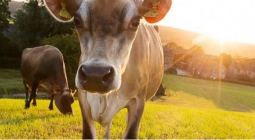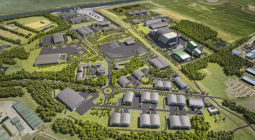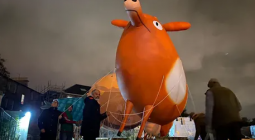California subsidies for dairy cows’ biogas are a lose-lose, campaigners say

The state pumps millions into methane produced by manure – but advocates argue it increases greenhouse gas emissions and encourages factory farming
A coalition of climate, environmental and animal welfare groups is calling for California to remove the huge subsidies provided to dairy farms to turn animal waste into a form of energy called biogas.
Manure, which emits the potent greenhouse gas methane, is a big problem for US farms, and is particularly stark in California, where the dairy industry accounts for nearly half the state’s methane emissions.
Since 2011, California has been running a policy called the low carbon fuel standard (LCFS), which now includes incentives for dairy farms to convert methane into energy to fuel vehicles by enabling them to sell offset credits. This is intended to be a win-win: reducing farm emissions while allowing fossil fuel companies to mitigate their own greenhouse gas emissions by buying these offsets. The number of anaerobic digesters used to produce the biogas has surged in the state especially among large dairy farms.
But environmental advocates argue that the environmental benefits of biogas are exaggerated, and that the LCFS encourages the expansion of factory farms and could end up increasing emissions and pollution.
In a petition to the California Air Resources Board (Carb), the state government’s clean air agency that runs the LCFS, six environmental groups called for dairy farms to be excluded from the policy. In January, Carb turned down the request but said it would continue to engage with the petitioners.
This decision will “kick the can down the road [and] ensures that the program will remain fundamentally compromised and California will fall further behind its climate goals,” said Tyler Lobdell, a staff attorney with Food & Water Watch, one of the organizations involved in the petition.
While biogas from manure is marketed as a clean alternative to fossil fuel, said Phoebe Seaton, co-director and attorney at the non-profit Leadership Counsel for Justice and Accountability, a signatory to the petition, “in fact it burns the same, has many of the same environmental impacts and has enormous local impacts at its production”.
Under the current credit system in California, biogas from dairy farms can receive carbon intensity ratings that are 200% to 300% lower than a battery electric car powered by renewable energy from solar or wind. “That is a really stark example of the bizarre and perverse incentives that are being driven by this program,” Lobdell said. “Who in their right mind thinks that we should be prioritizing factory farm gas, which is still a combustion-based energy source?”
Brent Newell, a food project senior attorney at the legal advocacy non-profit Public Justice, cited the Aliso Canyon natural gas leak settlement in California, as an example of problems with the credit program. In 2015, a ruptured well at Aliso Canyon natural gas storage facility caused the US’s largest ever methane leak. As part of a settlement, the owner of the facility, Southern California Gas Company, agreed to pay more than $26m towards the construction of digesters at dairy farms.
“These facilities are getting money from the Aliso Canyon settlement fund, they’re getting money from the state, and under both of those systems, they’re getting credit for reducing the same reductions twice, then they’re selling reduction credits in the market,” said Newell.
Without government subsidies and grants, digesters may not be profitable according to an analysis conducted by UC Davis researchers, which found that it costs $294 a year to produce $68 of gas from one cow, excluding the upfront cost of building the digester. With LCFS credits, the revenue loss is turned on its head: one cow generates a subsidy of $1,935 a year, according to analysis by Aaron Smith, DeLoach professor of agricultural economics at UC Davis.
The global biogas industry is projected to more than double by 2030 to over $126.2bn and this type of methane production could become more lucrative in the dairy industry than milk production. California has spent more than $600m since 2015 on subsidizing the construction of digesters, primarily at large factory farms with average herds of about 7,000 cows in 2017 and 2018.
The Union of Concerned Scientists has criticized dairy biogas subsidies as “excessive” and vastly exceeding the costs of producing methane from manure. An analysis by the organization indicated that the LCFS will also disproportionately benefit the largest, most polluting dairy farms, potentially increasing industry consolidation as well as disincentivizing other methods of reducing methane emissions.
“The revenue from the low carbon fuel standard-related subsidies is actually driving this ongoing intensification of the dairy industry and intensifies local impacts,” said Seaton. Large dairy operations have been linked to water pollution, air pollution, and health problems for residents in communities where these operations are concentrated, in addition to emissions contributing to the climate crisis.
“We would not be processing biogas and using it as a replacement for fossil natural gas without these subsidies,” said Smith.
In response to the criticisms of the LCFS credit system, Carb, said the agency was “committed to ensuring our program focuses on environmental justice and environmental integrity” but that “specific requests for a near-term rulemaking are premature”. A Carb spokesperson added that there would be a public workshop in the coming weeks to delve into claims regarding the LCFS program and its impact on the dairy sector.
cover photo: Cows at a dairy in California, where the state has spent $600m on incentives to dairy farmers to convert animal waste into biogas Photograph: Mike Blake/Reuters





